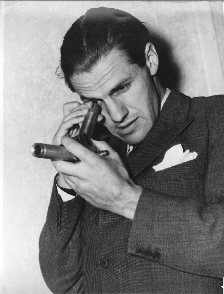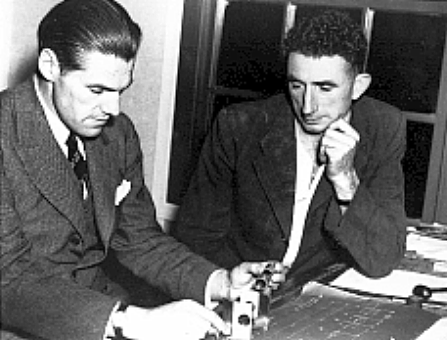





Richard van der Reit Woolley was born in 1906, in Dorset, England. He was educated in England and South Africa, then worked at Cambridge University in the UK and Mount Wilson in California, USA. Woolley was appointed Director of the Commonwealth Solar Observatory (CSO) in December 1939, aged only thirty-three! The CSO had not had a permanent head for ten years, and his arrival was most welcome. Woolley had plans of changing the emphasis of the CSO from solar and geophysical work to stellar astronomy; however, his plans were delayed by the onset of the Second World War.
My early years on Mount Stromlo were dominated by the work of the Optical Munitions Panel. I arrived in Australia shortly after the 1939 war broke out, and carried on normal work until the fall of France the next year ... [then] Mount Stromlo stopped doing ordinary scientific work almost entirely, and worked instead for the Panel.(1)
Woolley found many excellent scientists, technicians and people who contributed to the optical munitions work. He was responsible for recruiting S.C. 'Ben' Gascoigne, F. Lord, S.J. Elwin, J. Dooley, K. Gottlieb, many women, and even internees.

T.H. Laby had recommended Woolley as one
of the first appointees to the Optical Munitions Panel, calling him one of the finest mathematicians in the country. However, Laby and Woolley did not always see eye-to-eye. Prior to the formation of the Panel, Woolley had entertained similar ideas to Laby, that is, of providing scientific services to the Government during war time. Thus, he had his own well-formed plans on how it should work. He believed that the Panel was an awkward group with inadequate power and a lack of distinction between its scientific, advisory and executive functions, and felt it could have been organised more efficiently.
Woolley clashed with Laby on a number of occasions, in particular over who was in charge of optical design. At one early Panel meeting, Woolley had been told that the CSO was going to do all optical munitions design work, but then Laby started getting other
universities, and especially the University of Melbourne (his own), to do design work as well. These issues were eventually sorted out, and it seems that Woolley and Laby both had tendencies to dramatise some situations in order to get their own way.
After April 1942, Woolley's work as Chief Executive Officer of the Army Inventions Directorate (AID) regularly took him away from the CSO.
L.J. Hartnett had asked him to take on this role, as he believed Woolley was 'an excellent organiser and a fast worker'. (2) The AID's task was to investigate all ideas for inventions received from the Australian public in an attempt to determine those which would help the war effort. It received 21,645
submissions, 127 of which were actually developed. During this period,
Woolley trusted his CSO staff to carry on without him, which they admirably did.
Woolley was a sociable man, who encouraged a positive sense of community and teamwork at the CSO. He mixed with staff easily, playing chess with Lord, and taking part in bridge evenings, tennis matches, horse riding and musical performances. It appears that he was well liked as a Director.
After the Panel work was finished, Woolley wanted to keep the optical
workshops going with a 'small nucleus of skilled instrument makers' to
'keep alive in Australia some of the optical instrument knowledge gained
the hard way during the war'.(3) The optical workshops at Mount Stromlo are still among the best in the world.
Woolley stayed at Mount Stromlo Observatory (the former CSO) for sixteen years. During this time he helped in the establishment of the Australian National University (ANU), and encouraged the incorporation of the Observatory into the ANU. Woolley and his wife, Gwyneth, were also very involved in the planning and governing of University House at the ANU.
In 1955 Woolley took up the post of Astronomer Royal in Britain, somewhat reluctantly leaving all his friends in Australia.
The latest Mount Stromlo office building, opened in 1995, was named the Woolley Building in his honour.
(1)
R. Woolley (1968), 'Mount Stromlo Observatory', RAAS,
vol 1, no. 3, November, p. 53.
(2)
Sir Laurence Hartnett (1973), Big Wheels and Little Wheels,
2nd edn, Gold Star Publications, Hawthorn, Victoria, p. 166.
(3)
R. v.d.R. Woolley to Secretary, Department of Interior, 28 May 1943, Australian Archives, A 431, 47/1629.








Published by the Australian
Science Archives Project on
ASAPWeb, 30 April 1997
Comments or corrections to:
Bright Sparcs (bsparcs@asap.unimelb.edu.au)
Prepared by: Denise Sutherland
and Elissa Tenkate
Updated by: Joanne Evans
Date modified: 4 January 1998
 Top |
Bright SPARCS |
ASAPWeb
Top |
Bright SPARCS |
ASAPWeb
